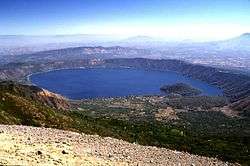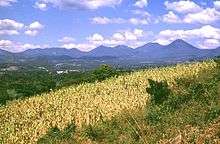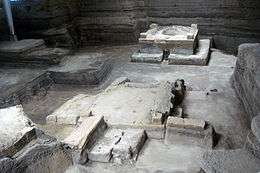Tourism in El Salvador
Tourism accounts for a large part of El Salvador's economy. It offers many natural attractions including, beaches, a mild tropical climate and lush landscapes. It also offers an important archaeological and ecological heritage, with colonial and pre-Columbian vestiges, and national reserves.




El Salvador also has an exceptional potential in the field of cultural tourism, with over 2,000 known archaeological sites, samples of Maya and Olmec cultures, mainly. They stand out for their importance the archaeological remains of the Pyramids of San Andrés, Joya de Cerén, Cihuatán, Quelepa, Tazumal and Tehuacán.
While tourism is an activity that exploded few over the past two decades due to political instability in times of civil war, after the Peace Accords, signed in 1992, there were new expectations, although its development went slowly due to lack of infrastructure in rural areas of the country because the government of the day established other priorities in economic policy, as the maquila.
A feature of the territory is that the extension is small. To El Salvador it is known as the country of the 40 minutes because from the capital it is accessed in that time to various tourist attractions: beaches along the south of the territory, mountains located west north and inland towns.
El Salvador had the fourth place in the highest murder rate in the world and it kept growing until 2018.[1] Nevertheless as of September 2019, after the first implementation of "Plan Control Territorial", which is a major government plan to reduce crime in El Salvador, murder rates have been substantially decreasing.
Volume of tourism
In 1994, the 181,000 tourists left the country 28.8 million dollars. Three years later was created a specialized governing body, called Salvadoran Tourism Corporation (Corporación Salvadoreña de Turismo) (Corsatur), that year entered 387,000 visitors and 74.7 million of dollars.
Since then, tourism has seen a significant increase over previous years. In 2004, the activity injected $424.7 million into the economy. It also created the Ministry of Tourism to direct the policy of the development of the sector. To promote the momentum of this activity, during 2005 has developed the Tourism Act (Ley del Turismo), which provides tax incentives for new investments in the sector.
In 2008, 1.8 million tourists visited the country, generating the economy with about $720 million, according to the Ministry of Tourism.
The growth no has been based on attracting tourism resort, but rather in the business and Salvadorans living in US returning to their country.
Tourism contributed US$855.5 million to El Salvador's GDP in 2013. This represented 3.5% of total GDP.[2]
Tourism directly supported 80,500 jobs in 2013. This represented 3.1% of total employment in El Salvador.[3] In 2013, tourism indirectly supported 210,000 jobs, representing 8.1% of total employment in El Salvador.[4]
It was estimated that 1,394,000 international tourists would visit El Salvador in 2014.[5]
Despite advances, in Central America it is one of the country marching ahead of other established destinations such as Costa Rica and Guatemala.
The lack of promotion abroad and adequate infrastructure to host international tourism are some of the most cited problems. The pros are the substantial improvement of road infrastructure, the remodeling of El Salvador International Airport in Comalapa, southeast of San Salvador.40 km (25 mi) [6]
The airport serving international flights in El Salvador is Comalapa International Airport.
Historical Monuments
National Palace
At times of the government of Captain General Gerardo Barrios did the idea of a National Palace, whose construction was carried out in 1866 to 1870, by Don Idelfonso Marín and José Dolores Melara; However, on 19 November 1889 a fire reduced it to rubble.
The current National Palace was designed by the engineer José Emilio Alcaine and constructed in 1905 to 1911 under the direction of José María Peralta Lagos; as foreman served Don Pascasio González and construction materials were imported from Germany, Belgium, Italy and other countries.
On 13 December 1974, by legislative decree 165, it declared a national monument the Blue Room (Salón Azul) and the adjacent rooms and 10 July 1980, the Revolutionary Council of the Government, by Decree No. 116, declares the National Palace as "National Monument". It has four main halls in colors red, blue, yellow, pink, and 101 secondary rooms.
The Monument of Christopher Columbus and Queen Isabella
Both monuments are located side of the entrance of the main gate of the National Palace on Cuscatlán Avenue. They were unveiled on 12 October 1924 to place the 432º anniversary of the discovery of America. Both monuments were donated to the Salvadoran people by the King of Spain, Alfonso XIII, and officially handed over to the Government of El Salvador, during the administration of President Dr. Alfonso Quiñónez Molina.
Casa de las Academias
The former Casa Dueñas, owned of Dueñas family, was unoccupied for years. Then, in 1930 and 1933 was leased by the Legation of Mexico (at that time were not Embassies). From 1935 to 1957 the Legation of the United States rented the house for residence of the plenipotentiary ministers. And they lived there six American representatives diplomats, with occasional guests such as former presidents Richard Nixon and Lyndon B. Johnson and Senator Robert Kennedy and film artists Clark Gable and Tony Curtis.
Beaches
El Salvador also provides a supply of sun and beach. One of the most visited by tourists are those of La Libertad, in the central region of the country. There are a number of beaches and a variety of hotels and restaurants.
Beaches like El Tunco or El Sunzal are used for surfing. Some Europeans and Americans have visited for the Salvadoran waves, ranked among the best in the world for surfing.
In the Salvadoran beaches it can fish, surf, or just sunbathing. The entire coast of the country has many beaches, from Ahuachapán to La Unión.
The hotels offer are still under development, but in 2005 there have been several investments in the field of beach resorts. Casa de Mar, in El Sunzal; Pacific Sunrise, in La Libertad; Las Hojas, in Las Hojas Beach; Club Joya del Pacífico, on the Costa del Sol are already in operation.
The 'Royal Decameron' international hotel chain opened a modern, huge project of hotel in Salinitas Beach, which operates with the concept of all-incorporated. Also, local investors are planning to develop more the Costa del Sol and the Jiquilisco Bay. The latter site, located at Usulután, is one of the most heavenly attractions in the country for its natural diversity.
Environmental aspects

However, in recent decades, biodiversity and ecological balance of the country have suffered the harsh impact of urban planning and the pollution; the increasing concentration of population in urban areas has led to an increased bonding of the population in the South and Southwest regions of the country (especially in the Metropolitan Area of San Salvador). These areas are a fragile ecosystem, because in them are channeled and feed the aquifers of the southern corridor of the country, limiting the ability of water from underground sources.
The main causes of pollution and environmental pollution in El Salvador are mainly transport, industry, field burning and incineration of solid waste (about half of the waste generated in the metropolitan area of San Salvador no is recycled). To this it must add that the vast majority of households use firewood for cooking.
However, El Salvador still it has a large number of animal and plant species over other neighboring countries. However, the country can not relax in the task of recovery and conservation of the last natural areas, and project to create, in cooperation with the countries of the region, a biological corridor that maintains stable populations of endangered species.
Ecotourism
El Salvador has a range of national parks of great importance, both for its quantity and its uniqueness. The most important ecological areas are, among others:
- The National Reserve Forest El Imposible
- The Cerro Verde National Park
- Montecristo National Park
- The Conchagua Volcano National Park
- The Walter T. Deininger Park
- The Jocotal Lake
- The Forest of San Diego
- El Forest of Nancuchiname
The Forest El Imposible is located south of the department of Ahuachapán, on the mountain range of Apaneca, and covers an area of 3,130ha. It presents a difficult access, which owes its name, and offers shelter to many animal species (insects, birds, mammals and reptiles) and vegetables, including the Siete Camisas Rojo (Guapira Witsbereri) and Amarante Silvestre ( Parathesis Congesta), two tree species unknown to science until recently.
From Cerro Verde National Park, located in the department of Santa Ana, there are views of Izalco volcano, Santa Ana volcano and Lake Coatepeque. In this area there are more than 127 species of birds, and other animals.
Montecristo National Park, located north of the department of Santa Ana, comprises one of the last cloud forests of El Salvador, consisting of oaks, pines and cypresses, where it find its habitat howler monkeys, black shrews, anteaters, White tail deer and pumas.
Another exceptional faunal refuge constitutes the Walter T. Deininger Park, where the hunting ban has led to the population of coyotes, deer, tucanoan and iguanas. Waterfowl such as tree ducks, red-beaked redfish and charancuacos found in Jocotal Lake.
The Trifinio is one of the great forests, which shares its extension with Guatemala and Honduras - rivers, and above all, its villages, where much of the Salvadoran culture is still present and day to day lives.
Archaeological sites


El Salvador also has an exceptional potential in the field of cultural tourism, with over 2,000 known archaeological sites, samples of Maya and Olmec cultures, mainly. They stand out for their importance the archaeological remains of the Pyramids of San Andrés, Joya de Cerén, Cihuatán, Quelepa, Tazumal and Tehuacán.
The Tazumal is located in Chalchuapa, Santa Ana Department where it was built by a culture still not defined as shares Mayoid elements of the Guatemalan highlands and the valley of Copán in the early Classic period (around 260). It made many changes over the centuries in the end it became a splendid place showing the great culture of El Salvador. The tazumal remained independent after the fall of Copán and the arrival of the Pipiles.
Tourist Routes
The Ministry of Tourism of El Salvador, has established eight tourist routes. The last route in established was the "Route of the Volcanoes", which was created in 2009.
8 Tourist Routes are:
- Archaeological Route
Joya de Cerén, San Andrés, Santa Ana, Chalchuapa, Tazumal, Casa Blanca.
- Crafts Route
Ilobasco, Suchitoto, San Sebastián, Cihuatán, Colima, La Palma, San Ignacio, El Pital, Las Pilas, Miramundo, Citalá, Iglesia del Pilar.
- Route of La Paz
Perquín, Cacaopera, Arambala, Corinto,San Fernando.
- Route of the Thousand Peaks
Chaguantique Forest, Jiquilisco Bay, Tecapa Volcano and Alegría Lake, Berlín, Alegría.
- Rural and Cultural Route
Concepción de Ataco, Nahuizalco, Ilobasco, La Palma San Sebastián, Cihuatán, Joya de Cerén, San Andrés, Santa Ana, Chalchuapa, Tazumal, Casa Blanca, Iglesia Santiago Apóstol, Suchitoto, Panchimalco.
- Sun and Beach Route
Beaches of El Salvador:
- Central Zone: Palmarcito Beach, El Sunzal, El Tunco, La Paz, San Diego, Costa del Sol and Estero de Jaltepeque, El Zonte.
- West Zone: la Barra de Santiago Beaach, Metalío, Los Cóbanos,
- Eastern Zone: Jiquilisco Bay, El Espino Beach, El cuco, Las Flores, Las Tunas, Torola, Playas Negras, El Tamarindo and the Fonseca Gulf.
- Route of Las Flores
Salcoatitán , Nahuizalco, Juayúa, Apaneca and Concepción de Ataco.
- Route of the Volcanoes
Cerro Verde, Izalco and Santa Ana.
See also
- Salvadoran cuisine
- Crime in El Salvador
- Mara Salvatrucha
References
- Habarta, Petr (2015-01-08). "25 Countries With The Highest Murder Rates In The World". Retrieved 2016-10-04.
- "Travel and Tourism, Economic Impact 2014 - El Salvador", World Travel and Tourism Council, 2014, p. 1.
- "Travel and Tourism, Economic Impact 2014 - El Salvador", World Travel and Tourism Council, 2014, p. 1.
- "Travel and Tourism, Economic Impact 2014 - El Salvador", World Travel and Tourism Council, 2014, p. 1.
- "Travel and Tourism, Economic Impact 2014 - El Salvador", World Travel and Tourism Council, 2014, p. 5.
- "CEPA – Aeropuerto Internacional de El Salvador". Aeropuertoelsalvador.gob.sv. Archived from the original on 2006-02-13. Retrieved 2010-05-02.
External links

